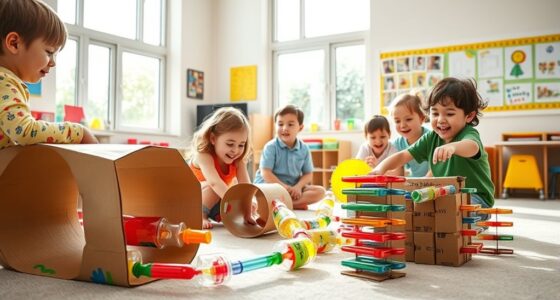Stop relying only on calming products or medication to manage your pet’s anxiety. Instead, focus on addressing root causes through positive reinforcement, routines, and environmental management. Avoid punishment and overstimulating environments, which can worsen stress. Respect your pet’s individual triggers and create a safe, predictable space. Combining these holistic strategies with gentle training offers more lasting relief. If you want to learn how to truly help your pet recover, keep going—there’s more you should know.
Key Takeaways
- Don’t rely solely on calming products or medication; address root causes with behavioral training and environmental enrichment.
- Avoid punishment and overstimulating environments; create calm, predictable spaces during anxiety episodes.
- Stop neglecting routine and safe spaces; establish consistent schedules and designated calm zones for your pet.
- Don’t ignore individual triggers; observe and use data-driven strategies to tailor stress management approaches.
- Avoid chaotic environments and harsh training; employ gentle socialization and calming techniques to build confidence.
Relying Solely on Calming Products Without Addressing Underlying Causes
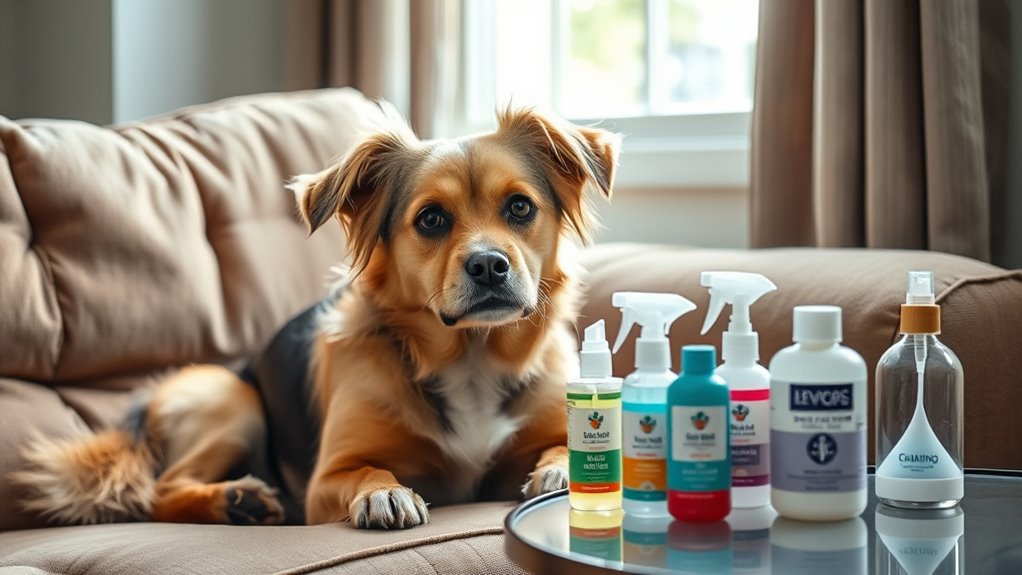
While calming products can provide temporary relief, relying solely on them ignores the root of your pet’s anxiety. To effectively help your pet, focus on positive reinforcement and environmental enrichment. Reward calm behavior to encourage your pet to feel secure and confident. Creating a stimulating environment, like puzzle toys or cozy hideouts, reduces stress triggers and keeps your pet engaged. These strategies address the underlying causes of anxiety rather than just masking symptoms. Over time, your pet can build resilience and learn to cope better with stressors. Incorporating mindfulness techniques, such as progressive relaxation techniques, can help your pet develop a sense of calm and security. Combining calming products with behavioral modifications ensures a more holistic approach. Remember, long-lasting relief comes from understanding your pet’s needs and actively working to meet them through positive, enriching experiences.
Using Punishment or Negative Reinforcement to Manage Anxiety

Using punishment or negative reinforcement to manage your pet’s anxiety often backfires, increasing stress instead of reducing it. Instead, focus on positive reinforcement to encourage calm behavior. Reward your pet when they relax or remain calm in stressful situations, which helps them associate good things with feeling secure. Environmental enrichment also plays a crucial role; providing toys, puzzles, and comfortable spaces keeps your pet engaged and reduces anxiety triggers. Punishment can damage trust and escalate fear, making anxiety worse. Additionally, understanding your pet’s anxiety triggers can help you tailor effective calming strategies. By emphasizing positive reinforcement and enriching your pet’s environment, you create a supportive atmosphere that promotes confidence and calmness. This approach not only addresses anxiety more effectively but also strengthens your bond, leading to healthier, happier behaviors over time.
Ignoring Routine and Consistent Exercise as Anxiety Management Tools
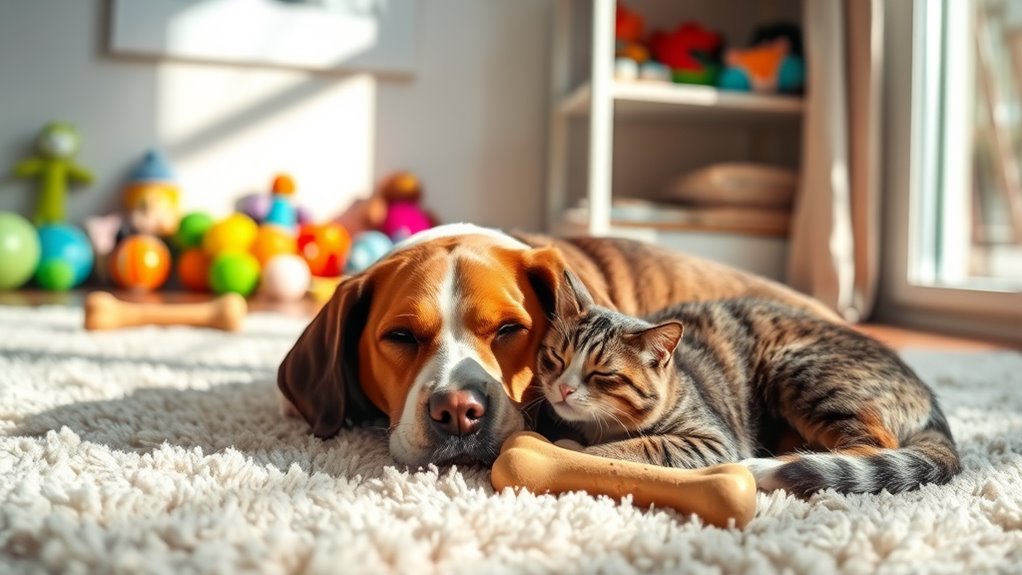
Skipping regular routines and consistent exercise can make your pet’s anxiety worse. Establishing a predictable schedule helps your pet feel safe and secure. When you stick to it, your pet gains confidence and reduces stress. Incorporating leadership skills into your routine, such as establishing clear and consistent rules, can further promote a sense of stability for your pet.
Subheading 1: The Power of Routine
Have you ever noticed how pets thrive on predictability? Establishing a consistent routine provides a sense of security, which is essential for managing anxiety. When your pet knows what to expect, it reduces stress and helps prevent unwanted behaviors. Incorporate behavior modification techniques by setting regular feeding, play, and rest times. Environmental enrichment also plays a crucial role—mentally stimulating activities can distract from anxious triggers and promote calmness. Consistency in daily habits creates a stable environment that reassures your pet, making it easier to manage anxiety naturally. Skipping routine or fluctuating schedules can increase uncertainty and worsen stress. Additionally, home environment factors such as appropriate lighting and sound levels can significantly influence your pet’s comfort and anxiety levels. By maintaining a structured daily rhythm, you empower your pet with the predictability they need to feel safe and secure.
Subheading 2: Consistency Builds Confidence
When you neglect to maintain a consistent routine and regular exercise schedule, your pet’s confidence can suffer, making anxiety worse. Consistency helps your pet feel secure, encouraging positive reinforcement and gradual exposure to new situations. Without it, they may become unsure and fearful. Building confidence requires patience and predictable practices that reinforce trust. Use positive reinforcement to celebrate small successes, and gradually expose your pet to new environments. This steady approach fosters resilience, reducing anxiety over time. Remember, a confident pet is less likely to be overwhelmed by stressors. Incorporating WWE Raw’s influence into your understanding of consistent routines can also highlight how stable structures promote confidence and reduce stress.
Overlooking the Power of a Safe and Comfortable Environment
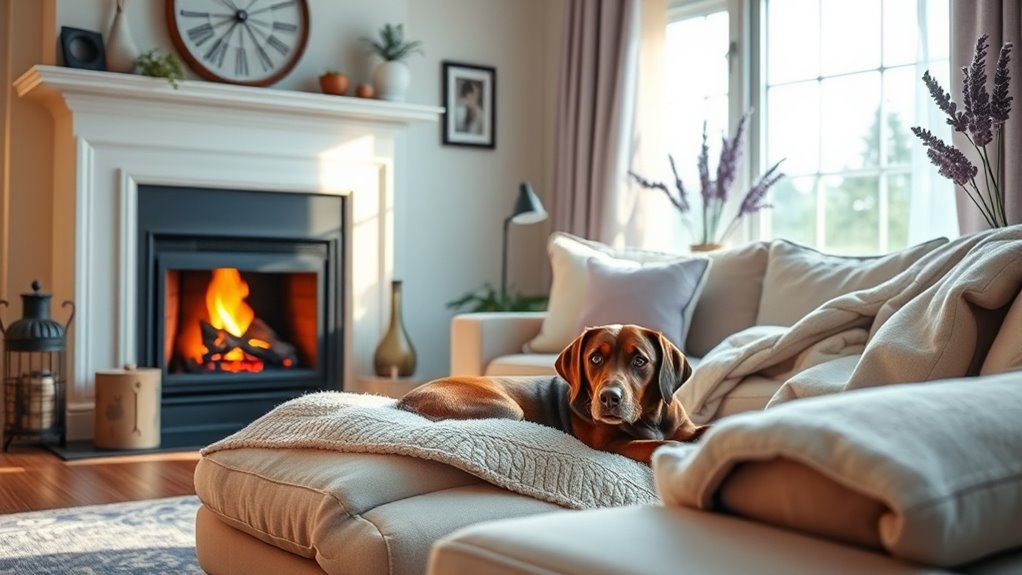
Creating a safe and comfortable environment is essential for reducing your pet’s anxiety, yet many owners overlook its importance. Environmental enrichment, like toys, cozy bedding, and designated safe spaces, helps your pet feel secure and relaxed. When your pet has a quiet spot to retreat to, they can escape stressful situations and regain composure. Ensuring the environment isn’t chaotic or loud also minimizes triggers that may heighten anxiety. A well-designed space should be inviting and predictable, giving your pet a sense of control. Remember, a calm, cozy environment isn’t just about comfort—it’s a foundation that supports your pet’s emotional well-being. By prioritizing safe spaces and enrichment, you’re actively helping your pet feel more secure and less anxious. Regular assessment and space organization can further promote a peaceful atmosphere for your furry friend.
Assuming Medication Is the Only Solution for Severe Anxiety
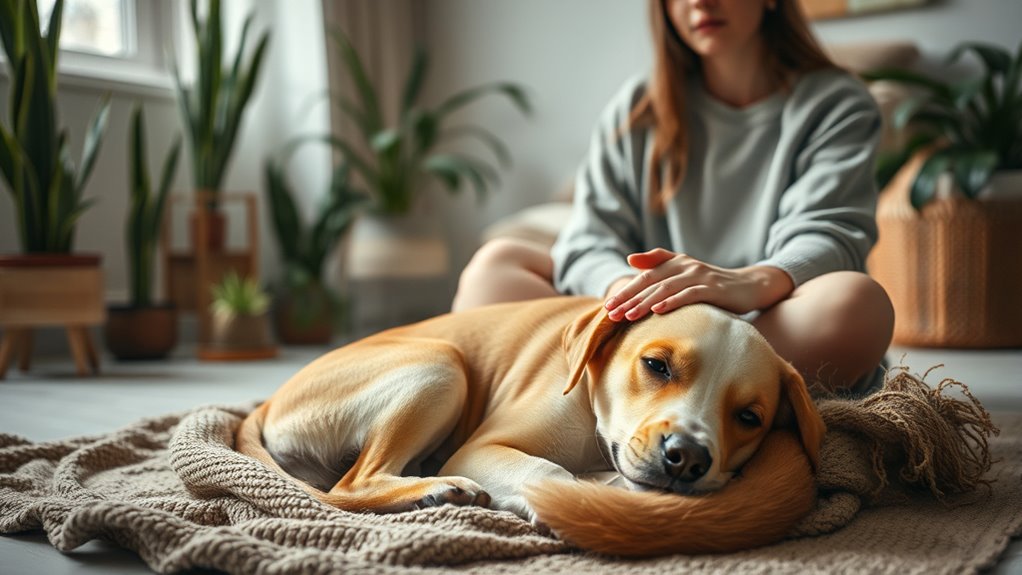
Many pet owners believe that medication is the only way to manage severe anxiety, but relying solely on drugs can overlook other effective strategies. Behavior modification techniques can reshape your pet’s responses, helping them feel more secure. Environmental enrichment also plays a crucial role by providing mental stimulation and comfort. Additionally, understanding your pet’s celebrity lifestyle insights can offer creative ideas for designing a calming environment tailored to their needs. Consider these approaches: 1. Incorporate positive reinforcement to encourage calm behavior. 2. Use scent-based calming aids or toys to reduce stress. 3. Create a consistent routine to build predictability. 4. Introduce environmental enrichment to engage your pet’s mind and reduce anxiety triggers. Medication can be helpful, but don’t forget these holistic strategies to support your pet’s emotional well-being and promote lasting relief.
Neglecting to Provide Mental Stimulation and Enrichment
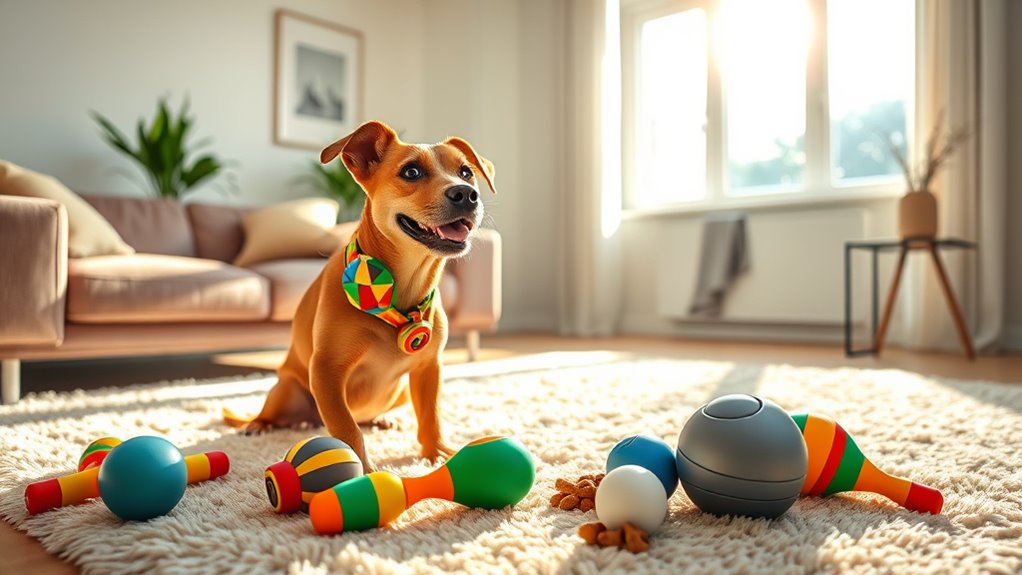
Neglecting to provide mental stimulation and enrichment can substantially worsen your pet’s anxiety symptoms. Without opportunities for mental engagement, pets become bored and stressed, which heightens their anxiety. Incorporate sensory enrichment by offering diverse toys, scent trails, or puzzle feeders that stimulate their senses. These activities help redirect their focus, reducing feelings of fear or loneliness. Enrichment also keeps their mind active, preventing destructive behaviors driven by boredom. Regularly changing toys or introducing new challenges keeps your pet engaged and mentally alert. By prioritizing mental stimulation, you create a calming environment that diminishes anxiety and builds confidence. Remember, a mentally enriched pet feels more secure, relaxed, and less prone to anxious outbursts. Kia Tuning offers additional ways to enhance your pet’s environment through customized modifications that can promote comfort and reduce stress.
Failing to Recognize and Respect Your Pet’s Individual Triggers
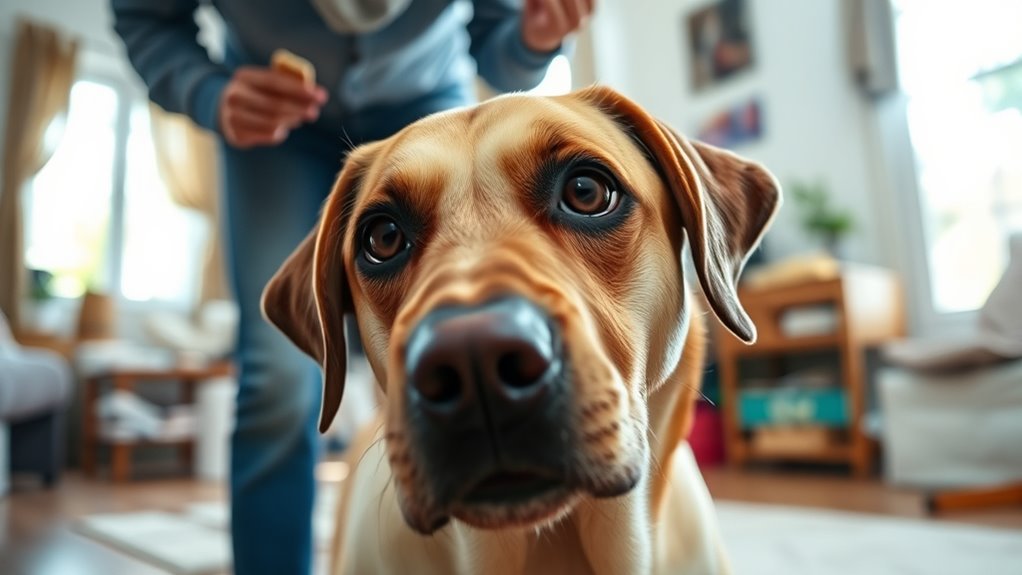
Understanding what triggers your pet’s anxiety is vital to managing their stress effectively. When you overlook their individual triggers, you risk making their anxiety worse. Every pet has unique sensitivities, so personalized approaches are essential. To identify these triggers, observe their reactions in different situations. For example:
- Loud noises like thunderstorms or fireworks
- Certain types of handling or touch
- Specific environments or unfamiliar places
- Sudden movements or unfamiliar people
Implementing data-driven strategies can help you better understand and address your pet’s specific stressors.
Relying on Stressful or Overstimulating Environments During Anxiety Episodes
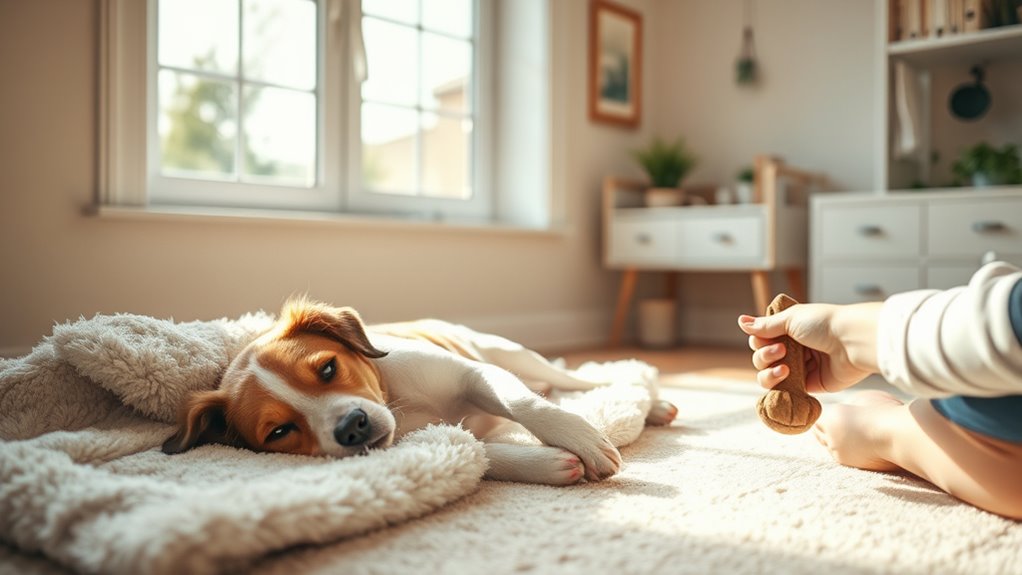
When your pet is anxious, exposing them to loud noises or chaotic environments only makes things worse. These overstimulating settings increase their stress rather than help them calm down. Instead, creating a peaceful space supports their recovery and comfort. As AI safety experts emphasize the importance of robust safety measures, it’s crucial to foster a calm environment for your pet’s well-being.
Overstimulating Environments Aggravate Anxiety
Exposing your pet to overstimulating environments during anxiety episodes can make their stress worse instead of providing relief. Sensory overload from loud noises, bright lights, or chaotic surroundings often triggers more anxiety. Instead of calming, these overstimulation triggers intensify their discomfort.
Consider these common overstimulating environments:
- Busy streets with honking cars and crowds
- Loud, chaotic gatherings or parties
- Bright, flashing lights or loud music
- Environments with too many unfamiliar scents or sounds
These scenarios flood your pet’s senses, increasing their anxiety. Instead of seeking refuge in these overstimulating settings, aim for calm, quiet spaces where they can feel safe and reduce sensory overload, helping them recover from stressful episodes.
Create Calm, Not Chaos
Instead of relying on stressful or overstimulating environments to soothe your pet during anxiety episodes, focus on creating a calm and predictable setting. Use gentle training techniques to reinforce relaxation and confidence, such as teaching your pet to settle on command and gradually exposing them to low-stress situations. Implement socialization strategies that build positive associations with new people, pets, and environments, reducing overall anxiety. Keep the environment quiet, soothing, and free of loud noises or sudden movements that can trigger panic. Consistency is key—maintain a steady routine to help your pet feel secure. By fostering a peaceful atmosphere and employing effective training techniques, you help your pet develop resilience, making anxiety episodes less overwhelming and easier to manage.
Frequently Asked Questions
How Can I Identify My Pet’s Specific Anxiety Triggers?
You can identify your pet’s specific anxiety triggers by observing their behavior cues during different situations and noting when they seem stressed or fearful. Pay close attention to how they react to environmental changes, like new visitors or loud noises. Keep a journal to track these instances, and over time, you’ll notice patterns that reveal what causes their anxiety, allowing you to address these triggers more effectively.
What Are Effective Non-Medical Strategies for Severe Pet Anxiety?
Are you ready to help your pet feel safe without medication? Focus on behavior modification and comfort techniques like creating a calm environment, using soothing sounds, and offering gentle massage. Consistency is key—reward calm behavior and gradually expose your pet to triggers in controlled ways. Have patience, and remember, your reassurance and routine provide powerful comfort that can markedly reduce severe anxiety naturally.
How Do I Create a Calming Environment for My Anxious Pet?
Create a calming environment for your anxious pet by providing a quiet, cozy space with familiar bedding and soothing background sounds like gentle music. Use stress reduction techniques such as massage or gentle petting to help them relax. Keep the environment dimly lit and minimize loud noises or sudden movements. Regular routines and safe hiding spots also promote a sense of security, helping your pet feel more at ease.
Can Routine Exercise Really Reduce My Pet’s Anxiety Levels?
Yes, routine exercise can markedly reduce your pet’s anxiety levels. Some might think it’s just physical activity, but it’s also a form of behavior modification that releases pent-up energy and stress. Incorporate calming techniques like gentle walks or play sessions to help your pet feel more secure. Regular exercise not only tires them out but also promotes mental well-being, making them calmer and more relaxed over time.
How Important Is Mental Stimulation in Managing Pet Anxiety?
Mental stimulation is essential in managing your pet’s anxiety because it helps redirect their focus and reduces stress. Incorporate behavior modification techniques and environmental enrichment, like puzzle toys or new scents, to keep their mind engaged. When your pet stays mentally active, they’re less likely to become overwhelmed by anxiety triggers, leading to a calmer, more confident companion. Prioritizing mental stimulation makes a significant difference in their overall well-being.
Conclusion
Stop relying solely on calming products, stop ignoring your pet’s individual triggers, stop using punishment or overexposure, and start addressing the root causes of anxiety. Create a safe environment, provide routine and mental enrichment, and respect their unique needs. By doing these, you’ll build trust, reduce stress, and help your pet feel secure. Because it’s not just about calming them in the moment — it’s about understanding, supporting, and improving their well-being for a lifetime.



